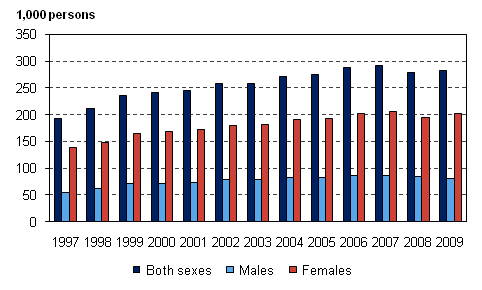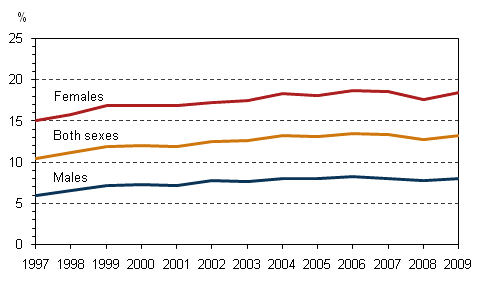2. Number of persons employed part-time has remained almost unchanged
Persons employed part-time numbered 343,000 in 2009. Of them, 238,000 were employees and 60,000 self-employed persons or assisting family members. The Labour Force Survey data on part-time employment is based on the respondents’ own reporting. The following only concerns part-time employees.
In 2009, the number of part-time employees remained almost unchanged from the previous year. Part-time employees made up 13 per cent of all employees in 2009. The prevalence of part-time employment has not altered much in the past few years. However, the longer term trend in part-time employment has been a growing one since 1997. (Figures 4 and 5).
Part-time employment is more widespread among women than men. Among female employees, persons employed part-time numbered 202,000, or 18 per cent, and among male employees 81,000, or 8 per cent. Approximately three-quarters of the employees employed part-time worked in the private sector. Part-time working was most frequent in the female dominated industries of wholesale and retail trade, and health and social work.
Figure 4. Part-time employees aged 15–74 by sex in 1997–2009

Figure 5. Share of part-time employees among employees aged 15–74 by sex in 1997–2009

2.1 Studying the commonest reason for working part-time
Doing part-time work suits the life situation of many of those who are employed part-time. By contrast, part-time employment can be viewed as one form of underemployment in cases where the employee has not succeeded in finding full-time work even if he/she would have wanted it.
The commonest reason for working part-time was studying. Approximately 30 per cent of part-time employees quoted studying as the reason for working part-time. Indeed, working part-time is widespread among young people, for as many as 40 per cent of employees between the ages of 15 and 24 worked part-time in 2009.
Other reported reasons relating to life situation were caring for children or relatives, and health reasons. Approximately 24,000 persons, almost all of them women, reported caring for children or relatives as the reason for working part-time.
For just under one-third of part-time employees the reason for working part-time was that full-time work was not available. In 2009, the number of employees working part-time involuntarily was 81,000. Of them, 59,000 were women and 22,000 men.
One important reason for working part-time is part-time retirement. According to the Labour Force Survey, 36,000 persons were in part-time retirement in 2009. In the 55–64 age group, the share of part-time employees was 17 per cent. The reasons for working part-time had not changed much between 2008 and 2009.
Source: Labour force survey 2009. Statistics Finland
Inquiries: Anna Pärnänen (09) 1734 2607, Päivi Keinänen (09) 1734 3416, tyovoimatutkimus@stat.fi
Director in charge: Riitta Harala
Updated 1.6.2010
Official Statistics of Finland (OSF):
Labour force survey [e-publication].
ISSN=1798-7857. 15 2009,
2. Number of persons employed part-time has remained almost unchanged
. Helsinki: Statistics Finland [referred: 28.12.2025].
Access method: http://stat.fi/til/tyti/2009/15/tyti_2009_15_2010-06-01_kat_002_en.html

